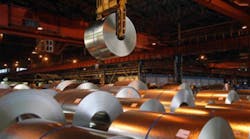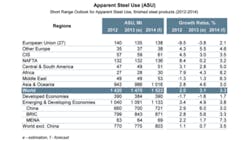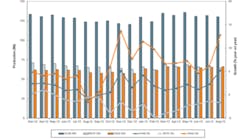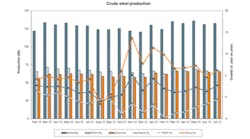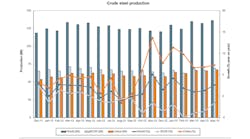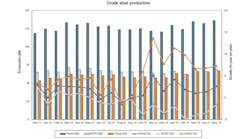The World Steel Association issued a Short Range Outlook report for global steel consumption, meaning the remainder of 2013 and 2014, and predicted that volumes would rise 3.1% over that period. In terms of tonnage, that projection would mean 2013 global steel consumption would rise to 1.475 billion metric tons– a 2% increase over the actual figure for 2012 — and increase further to 1.523 billion metric tons in 2014.
The forecast is slightly more positive for growth than the preceding Short Range Outlook, issued in April. But, the optimism remains guarded: “With risks within the developed world receding there is some uncertainty emerging from developing countries due to unresolved structural issues, political instability, and volatile financial markets,” the announcement offered. “All in all, despite economic conditions for the global steel industry remaining uncertain and challenging, we are forecasting further growth for steel demand in 2014.”
“The key risks in the global economy – the Euro Zone crisis and a hard landing for the Chinese economy – which we identified in our last SRO issued in April, have continued to stabilize through the last six months,” explained Hans Jürgen Kerkhoff, the chairman of the World Steel Economics Committee. “Our underlying assumption remains that the U.S. will resolve its fiscal constraint soon. The correction in the Euro Zone has been more severe than we forecasted but the improvement seen recently is now expected to continue for the rest of 2013.”
Increases in steel consumption in emerging economies (namely India and Brazil) have failed to materialize, which the forecasters attribute to “key structural issues,” and these factors have led to a lower steel demand performance than predicted across the world.
Trouble in China?
The constant exception to this rule is China, and the forecasters now predict 2013 steel demand will rise 6.0% there, to 699.7 million metric tons. “Thus, despite steel demand growing by only 0.7% in the rest of the world, total global steel demand will grow by 3.1%,” according to their statement.
However, the forecasters expect slower growth in China during 2014, just 3%, as the Chinese government continues to restrain investment.
In the U.S. market, following 7.8% increase in steel demand during 2012, consumption of steel in 2013 is forecast to grow by just 0.7% to 96.9 million metric tons. The volume will increase by 3% in 2014, they predicted, driven by improvements in global economy and more specifically by demand in the automotive, energy and residential construction sectors. For the broader NAFTA region, steel consumption will grow by just 0.2% this year, and 3.2% in 2014, the forecast indicated.
The European Union has endured continuing declines in steel consumption during 2013, and the forecast is reading this to mean a second consecutive year of decline, -3.8% to 134.9 million metric tons, following the -9.5% drop in 2012.
“Signs of stabilization in real steel use in the second half of 2013 bode well for recovery prospects in 2014,” according to the report. “However, the pickup in EU27 is expected to remain weak with steel demand increasing only by 2.1% in 2014 to 137.8 million metric tons.”
The new report was issued by the World Steel Assn. on the occasion of its annual meeting, this year in São Paulo, Brazil. The group represents 170 steelmakers in 64 countries who produce an estimated 85% of all the steel produced in the world.
The semi-annual report is a product of the Association’s Committee on Economic Studies, which includes economists from over 40 of the member companies. They evaluate demand estimates for national and regional markets to compile a global overview on “apparent steel use.”
